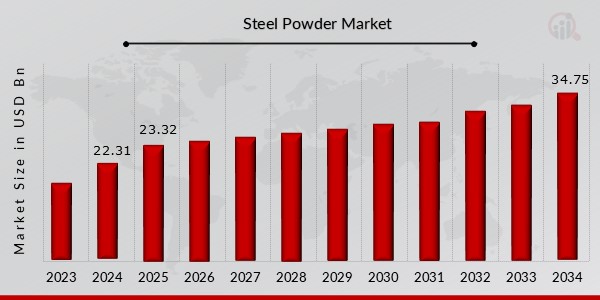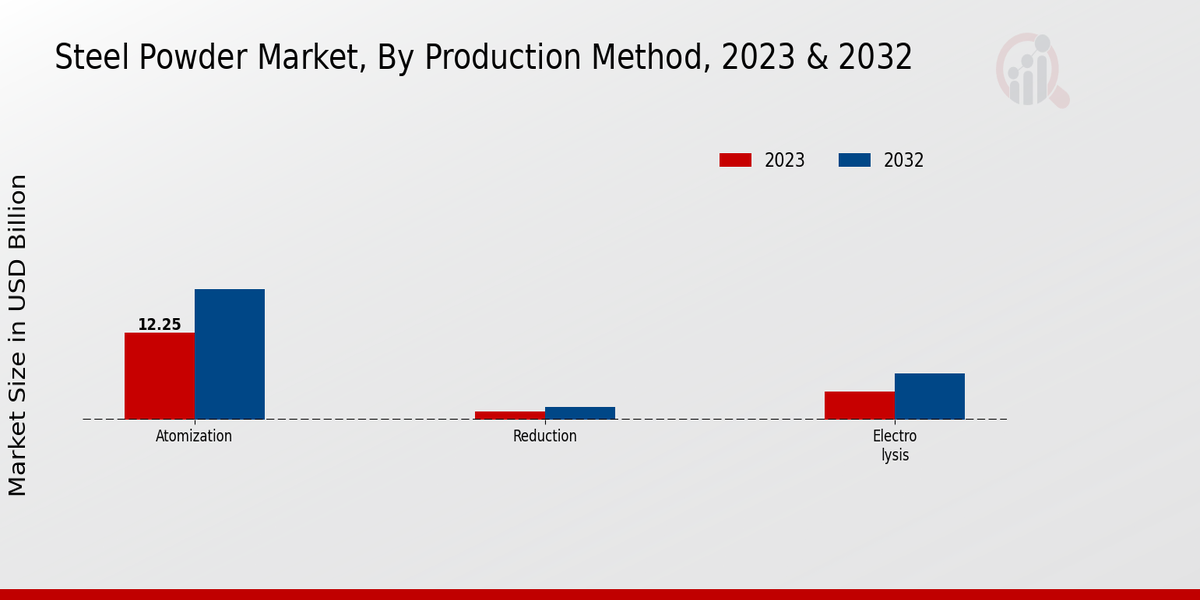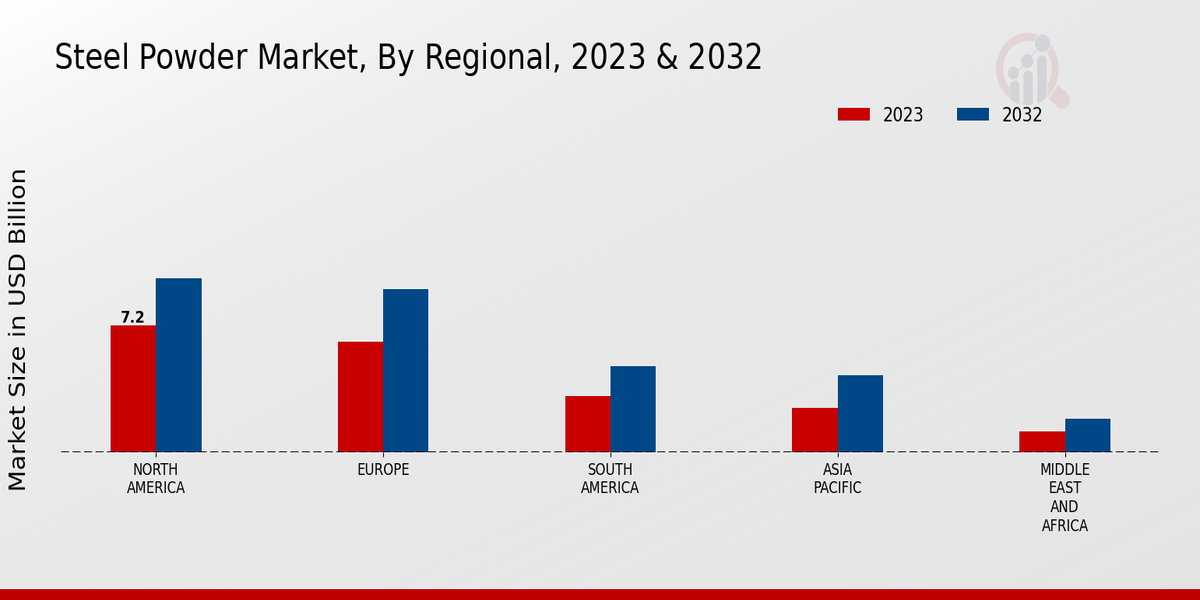Global Steel Powder Market Overview
The Steel Powder Market Size was estimated at 22.31(USD Billion) in 2024.The Steel Powder Industry is expected to grow from 23.32(USD Billion) in 2025 to 34.75(USD Billion) by 2034. The Steel Powder Market CAGR (growth rate) is expected to be around 4.50% during the forecast period (2025 - 2034).
Key Steel Powder Market Trends Highlighted
The Steel Powder Market is characterized by increasing demand from the automotive, construction, and manufacturing industries. The rising popularity of metal additive manufacturing and powder metallurgy techniques is also driving market growth. Key market drivers include the growing demand for high-performance and cost-effective materials in various applications.Opportunities for exploration exist in developing advanced alloys and tailored powders for specific end-use requirements. Recent trends in the market include the adoption of sustainable manufacturing practices, the use of recycled steel powder, and the integration of artificial intelligence and automation in production processes.
The market is expected to continue to expand as the demand for steel powder in various industries remains strong.

Source: Primary Research, Secondary Research, Market Research Future Database and Analyst Review Steel Powder Market Drivers
Increasing Demand from Automotive Industry
The automotive industry is a major consumer of steel powder, particularly in the production of components such as gears, connecting rods, and brake pads. The growing demand for lightweight and fuel-efficient vehicles is driving the adoption of steel powder metallurgy, as it offers higher strength-to-weight ratios and improved durability compared to traditional manufacturing methods. Additionally, the increasing production of electric vehicles is expected to further boost the demand for steel powder, as it is used in the manufacturing of battery packs and other components.
Expansion of Aerospace and Defense Sector
The aerospace and defense sector are another key driver of growth in the Steel Powder Market Industry. Steel powder is used in the production of aircraft components, such as landing gear, engine parts, and structural elements. The increasing demand for lightweight and high-performance materials in the aerospace industry is driving the adoption of steel powder metallurgy. Moreover, the growing investments in defense spending worldwide are expected to further stimulate the demand for steel powder in the production of military equipment and weapons systems.
Advancements in Additive Manufacturing
Additive manufacturing, also known as 3D printing, is a rapidly growing technology that is transforming the manufacturing industry. Steel powder is a key material used in additive manufacturing, as it allows for the production of complex and intricate components with high precision. The growing adoption of additive manufacturing in various industries, including automotive, aerospace, and healthcare, is expected to drive the demand for steel powder in the coming years.
Steel Powder Market Segment Insights Steel Powder Market Production Method Insights
The Steel Powder Market is segmented by Production Method into Atomization, Reduction, and Electrolysis. Atomization is the most widely used method, accounting for over 60% of the Steel Powder Market revenue in 2023. Atomization involves disintegrating molten steel into fine droplets using high-pressure water jets or gas, resulting in spherical powder particles. This method offers high production rates, good powder quality, and versatility in terms of particle size and shape. Reduction, on the other hand, involves reducing iron oxides to obtain steel powder.It is a less common method, but it produces high-purity powder with controlled particle size and shape.
Reduction methods include solid-state reduction, where iron oxide is mixed with a reducing agent and heated, and gas-based reduction, where iron oxide is reduced using hydrogen or carbon monoxide. Electrolysis is another method used to produce steel powder, but it is less common than Atomization and Reduction. Electrolysis involves passing an electric current through a molten electrolyte containing dissolved iron salts. This process produces high-purity spherical powder particles with controlled size and shape.However, electrolysis is more energy-intensive and expensive compared to other methods.
The choice of Production Method depends on factors such as desired powder characteristics, production capacity, and cost considerations. Atomization is preferred for high-volume applications and general-purpose powders, while Reduction and Electrolysis are suitable for specialized applications requiring high purity and specific particle properties. The market growth for each Production Method segment is influenced by technological advancements, industry trends, and demand from end-use industries such as automotive, aerospace, and construction.
 Source: Primary Research, Secondary Research, Market Research Future Database and Analyst Review Steel Powder Market Particle Size Insights
Source: Primary Research, Secondary Research, Market Research Future Database and Analyst Review Steel Powder Market Particle Size Insights
The Steel Powder Market segmentation by Particle Size comprises Fine (50 microns), Medium (50-500 microns), and Coarse (>500 microns). Fine steel powder is anticipated to dominate the market over the forecast period owing to its superior mechanical properties, higher surface area, and enhanced sinterability. Medium steel powder is projected to witness significant growth due to its increasing adoption in the production of high-strength components, cutting tools, and wear-resistant parts.
Coarse steel powder is expected to gain traction in the construction industry for applications such as metal additive manufacturing and surface coating.The Steel Powder Market revenue from Fine steel powder is poised to reach USD 8.4 billion by 2024, while Medium steel powder is projected to reach USD 6.2 billion, and Coarse steel powder is expected to reach USD 3.6 billion by the same year.
Steel Powder Market Application Insights
The Steel Powder Market is segmented based on Application into Additive Manufacturing, Powder Metallurgy, Welding and Hardfacing, and Other Industrial Applications. Among these segments, Additive Manufacturing is anticipated to hold a significant market share in the coming years. The market growth can be attributed to the rising adoption of 3D printing technology in various industries, including aerospace, automotive, and healthcare. Powder Metallurgy is another major segment in the Steel Powder Market, accounting for a considerable market share.The increasing demand for high-performance components in industries such as automotive and aerospace is driving the growth of this segment.
Welding and Hardfacing applications of steel powder are also witnessing significant growth due to their advantages in terms of reducing wear and tear and enhancing the durability of components. Other Industrial Applications of steel powder include its use in friction materials, cutting tools, and magnetic components. The demand for steel powder in these applications is expected to grow steadily in the coming years due to the increasing industrialization and urbanization worldwide.
Steel Powder Market Form Insights
The Steel Powder Market segmentation by form comprises powder, paste, and pre-alloyed powder. Among these, the powder segment held the largest market share in 2023, and it is projected to continue its dominance throughout the forecast period. The growth of the powder segment can be attributed to its high demand in various industries, such as automotive, construction, and manufacturing. Powdered steel is a versatile material that can be used in a wide range of applications, including metal injection molding, powder metallurgy, and additive manufacturing.The paste segment is expected to witness a significant growth rate during the forecast period.
Paste steel powder is a mixture of steel powder and a binder, which makes it easier to handle and apply than pure steel powder. It is commonly used in applications where precise shaping is required, such as in the production of gears and cutting tools.
Steel Powder Market Grade Insights
The Steel Powder Market is segmented by Grade into Low Alloy, Medium Alloy, High Alloy, and Stainless Steel. Among these, the Low Alloy segment held the largest market share in 2023, accounting for around 35% of the Steel Powder Market revenue. The growth of this segment can be attributed to the increasing demand for low alloy steel powder in automotive applications, such as in the production of gears, shafts, and other components.
The Medium Alloy segment is expected to witness the highest growth rate during the forecast period, owing to the rising demand for medium alloy steel powder in aerospace and defense applications.The High Alloy and Stainless Steel segments are also expected to exhibit significant growth, driven by their increasing use in various industrial applications, including oil and gas, chemical processing, and power generation.
Steel Powder Market Regional Insights
The regional segmentation of the Steel Powder Market offers valuable insights into the market's geographical distribution and growth dynamics. North America is anticipated to maintain its dominance in the market throughout the forecast period, with a projected revenue of USD 7.2 billion in 2024. The region's robust automotive and manufacturing industries drive demand for steel powder. Europe, with its well-established automotive and construction sectors, is another key market, expected to reach USD 6.3 billion in 2024.
APAC, led by China, is poised for significant growth owing to the region's rapidly expanding infrastructure and manufacturing industries.South America and MEA are also expected to contribute to the market's growth, albeit at a slower pace. These regions present opportunities for steel powder manufacturers to cater to growing demand from emerging economies.
 Source: Primary Research, Secondary Research, Market Research Future Database and Analyst Review Steel Powder Market Key Players And Competitive Insights
Source: Primary Research, Secondary Research, Market Research Future Database and Analyst Review Steel Powder Market Key Players And Competitive Insights
Major players in the Steel Powder Market industry are continually making advancements to meet evolving customer demands. Leading Steel Powder Market players are focusing on research and development to launch innovative products and strengthen their market position. Strategic collaborations and partnerships are also prevalent in the Steel Powder Market development landscape, enabling companies to expand their reach and enhance their competitive edge. The Steel Powder Market Competitive Landscape is characterized by a mix of established players and emerging entrants.Hoeganaes Corporation, one of the leading companies in the Steel Powder Market, has a strong global presence and a diverse product portfolio.
The company is focused on providing high-quality steel powders for various industries, including automotive, aerospace, and medical. Hoeganaes Corporation has invested in research and development to create innovative products and solutions for its customers. The company's commitment to customer satisfaction and technical expertise has contributed to its success in the Steel Powder Market.Carpenter Technology Corporation, a prominent competitor in the Steel Powder Market, is known for its specialty alloys and materials. The company offers a range of steel powders tailored to meet the specific requirements of its customers.
Carpenter Technology Corporation has a strong distribution network and a global presence, enabling it to serve a diverse customer base. The company's focus on quality and innovation has positioned it as a reliable supplier in the Steel Powder Market.
Key Companies in the Steel Powder Market Include
Steel Powder Market Industry Developments
Steel powder is establishing a strong position as a potential friction material in advanced automotive systems.Steel powder is expected to observe greater adoption in additive manufacturing and 3D printing applications, which has created lucrative expansion opportunities for market players.In May 2023, Hganäs AB expanded its production capacity for advanced metal powders at its site in Belgium, aiming to meet the growing demand for metal powders in the automotive and additive manufacturing industries.Market players are also investing in research and development to improve the properties of steel powder and expand its applications.
For instance, in February 2023, Nippon Steel Corporation announced the development of a new steel powder production technology that enables the mass production of high-performance steel powders with excellent magnetic properties.
Steel Powder Market Segmentation Insights
-
Steel Powder Market Production Method Outlook
-
Steel Powder Market Particle Size Outlook
-
Steel Powder Market Application Outlook
- Other Industrial Applications
-
Steel Powder Market Form Outlook
-
Steel Powder Market Grade Outlook
-
Steel Powder Market Regional Outlook
| Report Attribute/Metric |
Details |
| Market Size 2024 |
22.31(USD Billion) |
| Market Size 2025 |
23.32(USD Billion) |
| Market Size 2034 |
34.75(USD Billion) |
| Compound Annual Growth Rate (CAGR) |
4.50% (2025 - 2034) |
| Report Coverage |
Revenue Forecast, Competitive Landscape, Growth Factors, and Trends |
| Base Year |
2024 |
| Market Forecast Period |
2025 - 2034 |
| Historical Data |
2020 - 2024 |
| Market Forecast Units |
USD Billion |
| Key Companies Profiled |
Sandvik, Essentium, Molycorp Minerals, Hitachi Metals, Carpenter Technology, Erasteel, AP, Markforged, Admatec, GKN Hoeganaes, AMETEK, BASF, LPW Technology |
| Segments Covered |
Production Method, Particle Size, Application, Form, Grade, Regional |
| Key Market Opportunities |
· Emerging advanced manufacturing technologies · Growing demand from the automotive and aerospace industries · Increasing adoption in powder metallurgy · Substitution for traditional materials · Lucrative opportunities in Asia Pacific |
| Key Market Dynamics |
Increased demand in automotive construction and manufacturing sectors, Technological advancements leading to improved powder properties, Growing adoption of metal injection molding, Sustainable initiatives driving demand for recycled steel powder, Regional variations in market growth due to economic factors |
| Countries Covered |
North America, Europe, APAC, South America, MEA |
Frequently Asked Questions (FAQ):
The Steel Powder Market size is expected to reach USD 23.32 billion by 2025 and is projected to reach USD 34.75billion by 2034, exhibiting a CAGR of 4.50% during the forecast period.
The growth of the Steel Powder Market is attributed to the increasing demand for steel powder in various applications, including automotive, construction, and manufacturing industries.
North America is expected to hold the largest market share in the Steel Powder Market due to the presence of major steel-producing countries such as China and India.
Major applications of Steel Powder include powder metallurgy, metal injection molding, and additive manufacturing.
Key players in the Steel Powder Market include Hoeganaes Corporation, Carpenter Technology Corporation, and BASF SE.
The Steel Powder Market is expected to grow at a CAGR of 4.53% during the forecast period from 2025 to 2034.
The Steel Powder Market is segmented based on type, application, and region.
Challenges faced by the Steel Powder Market include the availability of raw materials, environmental regulations, and competition from alternative materials.
Opportunities for growth in the Steel Powder Market include the development of new applications, technological advancements, and increasing demand from emerging economies.
Key trends in the Steel Powder Market include the increasing adoption of additive manufacturing, the development of new powder production technologies, and the growing demand for lightweight materials.






 Source: Primary Research, Secondary Research, Market Research Future Database and Analyst Review Steel Powder Market Particle Size Insights
Source: Primary Research, Secondary Research, Market Research Future Database and Analyst Review Steel Powder Market Particle Size Insights  Source: Primary Research, Secondary Research, Market Research Future Database and Analyst Review Steel Powder Market Key Players And Competitive Insights
Source: Primary Research, Secondary Research, Market Research Future Database and Analyst Review Steel Powder Market Key Players And Competitive Insights







